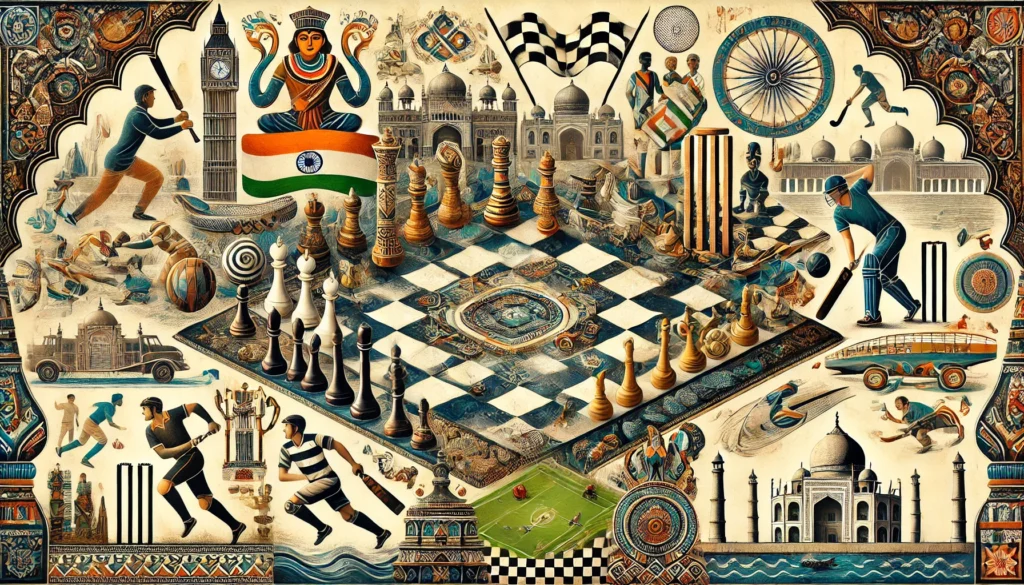Traditional Indian Board Games and Their Influence on Modern Strategy Sports
India has a rich history of traditional board games that have not only entertained generations but have also laid the foundation for modern strategy-based sports. These games, with their deep-rooted cultural and historical significance, go beyond mere entertainment. They teach critical thinking, strategic planning, patience, and adaptability—skills that are directly transferable to today’s competitive sports and strategy games. The influence of these ancient games can still be seen in the way sports are approached, from tactical decision-making in team sports to the mental discipline required in individual competitions. Games like Chaturanga, Pachisi, and Gyan Chaupar, once played by kings and commoners alike, have transcended time and continue to impact modern strategy sports. Their rules, philosophies, and methods of play have been passed down through generations, adapting and evolving along the way. As we explore the connections between these traditional games and modern sports, it becomes clear that the strategic principles behind them remain just as relevant today as they were centuries ago.
Ancient Indian Board Games and Their Historical Significance
Traditional Indian board games have a long and fascinating history, often reflecting the social, moral, and intellectual values of the time. These games were not just forms of entertainment; they were tools for learning, strategy development, and even spiritual reflection.
Chaturanga – The Birthplace of Chess
One of the most significant contributions of ancient India to the world of strategy games is Chaturanga, believed to be the precursor to modern chess. Chaturanga was played on an 8×8 board, much like chess, and involved four divisions of the army—infantry, cavalry, elephants, and chariots—mirroring the real-life military formations used in warfare at the time. The game emphasized strategic thinking, long-term planning, and the ability to anticipate an opponent’s moves, skills that are essential in chess today. Chaturanga’s evolution into chess saw these principles become globally recognized, solidifying India’s contribution to one of the most intellectual games in the world.
Pachisi – India’s Royal Game
Pachisi, another famous traditional Indian board game, has been played in various forms for centuries. Known as the “game of the royals,” Pachisi was often played in large courtyards, with live participants acting as game pieces. The game’s objective involved moving pieces around the board based on dice rolls, with an emphasis on both strategy and luck. While Pachisi might seem simple at first glance, it required players to think several moves ahead, weighing risks and rewards. It influenced games like Ludo, which is popular globally today, highlighting its lasting appeal and influence on modern strategy games.
Gyan Chaupar – A Game of Karma and Morality
Gyan Chaupar, also known as Snakes and Ladders, was originally a game with deep moral and philosophical underpinnings. Played as a tool for teaching karmic lessons, the game featured ladders symbolizing virtues and snakes representing vices, with players ascending or descending based on their moral decisions. This game emphasized the role of luck and moral choices in one’s life journey, a concept that has influenced various modern games that incorporate chance and strategy. The moral lessons in Gyan Chaupar mirrored the belief in karma, teaching players that actions have consequences, a principle that resonates with strategic thinking in today’s competitive sports.
These ancient Indian games not only entertained but also educated players, imparting lessons in life, strategy, and morality. Their influence on modern games and sports remains profound, as they introduced concepts of strategic planning, foresight, and adaptability.
Strategic Elements in Traditional Indian Games
Traditional Indian board games were rich in strategic complexity, providing players with valuable lessons in tactics, adaptability, and long-term thinking. These elements are directly applicable to modern strategy sports, where quick decision-making and strategic foresight can determine the outcome of a game.
- Tactical Thinking
Games like Chaturanga required players to develop intricate tactical plans, anticipating their opponent’s moves while preparing counterattacks. This emphasis on tactical thinking is mirrored in modern sports like chess and even team sports like football, where strategy dictates how a match unfolds. Players must think several steps ahead, always considering how each move influences the game’s overall trajectory. - Long-term Planning
In many traditional Indian games, success depended on a player’s ability to plan for the long term. Whether it was navigating the complex board of Pachisi or managing resources in Gyan Chaupar, these games taught the importance of long-term planning. In modern sports, this translates to athletes and coaches devising strategies that take into account not only immediate actions but also the broader context of a season or competition. - Adaptability and Flexibility
Adaptability was a key element in traditional Indian games, where unexpected changes—such as the roll of dice or an opponent’s sudden move—required players to adjust their strategy. This adaptability is crucial in modern strategy sports as well, where players must quickly alter their tactics in response to changing conditions on the field or court. The ability to remain flexible, make quick decisions, and recover from setbacks is a common theme between these ancient games and today’s competitive sports.
The strategic elements found in traditional Indian board games have had a lasting influence on how modern sports are played and understood. Whether in chess, football, or esports, the principles of tactical thinking, long-term planning, and adaptability continue to shape the way athletes and players approach their games.
Top 5 Modern Strategy Sports Influenced by Traditional Indian Games
The influence of traditional Indian board games can be seen in a number of modern strategy-based sports and activities. Here are five such sports where this historical connection is particularly evident:
- Chess
Chess is perhaps the most direct descendant of Chaturanga, and it retains many of the strategic elements that were central to its ancient predecessor. The focus on strategy, anticipating an opponent’s moves, and thinking several steps ahead are all rooted in the original principles of Chaturanga. - Carrom
While Carrom is a relatively modern game, it shares similarities with ancient games like Pachisi in terms of requiring both precision and strategic thinking. Players must carefully calculate their shots and plan ahead, much like the strategic movements in Pachisi. - Snooker
Snooker, though a more recent addition to the world of sports, involves strategic planning and positioning similar to traditional Indian games. The focus on long-term strategy and tactical play is reminiscent of games like Chaturanga, where players must continuously think ahead to outmaneuver their opponents. - Table Tennis
Table tennis, though primarily a physical game, also involves a high degree of strategy. The mental game of anticipating an opponent’s shots, adapting tactics, and planning combinations of shots is very much in line with the strategic thinking seen in traditional Indian board games. - Kabaddi
Though Kabaddi is a physical contact sport, it also involves strategic teamwork and quick decision-making. Like Pachisi, where players move based on both strategy and chance, Kabaddi players must navigate the field with calculated risks, anticipating the moves of their opponents while coordinating with their team.
These modern strategy sports, while differing in form from traditional Indian board games, share the same underlying principles of strategy, foresight, and adaptability that have been passed down through generations.
Influence of Indian Games on Global Strategy Sports
The strategic foundations laid by traditional Indian board games have left a lasting legacy on global sports, particularly in the realm of strategy-based games. Indian games like Chaturanga and Pachisi have evolved and influenced some of the world’s most popular strategy sports, helping shape the way these games are played and understood.
Chess as an International Phenomenon
The most notable example of Indian influence on global strategy sports is chess. What began as Chaturanga has developed into a globally recognized and competitive sport, with millions of players participating in tournaments around the world. The strategic principles of chess—careful planning, foresight, and the ability to predict an opponent’s moves—are direct inheritances from Chaturanga. India’s rich chess history has also given rise to modern grandmasters like Viswanathan Anand, who have helped to bring the game full circle, reasserting India’s dominance in a sport it originally birthed.
Tactical Training in Modern Sports
The influence of Indian board games extends beyond chess. Many traditional Indian games required players to manage resources, think several steps ahead, and anticipate their opponent’s actions, principles that are now applied in tactical training for modern sports. Coaches and athletes use similar methods of strategic thinking to prepare for high-stakes games, tournaments, and competitions. This focus on strategy has become central to sports like cricket, football, and even esports, where tactics play a crucial role in determining the outcome.
The global spread of these strategic principles highlights the profound impact that traditional Indian games have had on shaping modern competitive sports, influencing not just how they are played but also how they are understood and appreciated.
Reviving Traditional Indian Games in the Modern Sports Ecosystem
As India continues to grow as a global sporting powerhouse, there is a renewed interest in reviving traditional Indian games and incorporating their strategic elements into the modern sports ecosystem. These games, with their rich cultural and strategic heritage, offer valuable lessons that can enhance the training and development of modern athletes.
Promoting traditional Indian board games as part of school curricula or community sports programs can help instill critical thinking, adaptability, and strategic planning in young athletes. By reintroducing these games to new generations, India can cultivate a culture that values both physical prowess and mental agility. This revival would not only preserve the nation’s cultural heritage but also contribute to the broader development of sports strategy in India.
Incorporating elements of these traditional games into modern sports training, such as using tactical thinking exercises inspired by Chaturanga or Pachisi, can provide athletes with new ways to approach competition. This blending of ancient and modern can create a unique and powerful sports culture that is rooted in India’s past but focused on the future of international sports competition.


